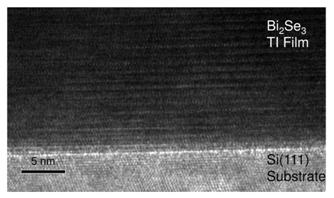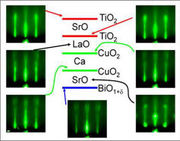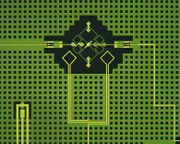Research
Topological Quantum Matter
In the 1980s the notion of classifying materials topologically emerged with the discovery of the Quantum Hall Insulator (QHI). When a strong magnetic field is applied to a 2D metallic state, the bulk of the material becomes insulating, much like an ordinary insulator. However, at the interface between the QHI and a "trivial" insulator, such as the vacuum, there exists a metallic surface state. This metallic surface state can be explained in terms of so called "topological invariants". Each insulator can be classified into a group based on its topological invariants. This is analogous to classifying geometrical objects based on their genus; all objects with one hole are of the same type and all with no holes are of another type.
Due to the difference in topological invariants across the interface between QHI and trivial insulator, a "smooth" interface is not possible. Instead, the topologically mismatched interface gives rise to metallic edge states. However, in the QHI, these edge states break time reversal symmetry (TRS), and can only be observed at high magnetic field.
The nontrivial, topologically protected state which obeys TRS can be realized when the magnetic field is replaced by spin-orbit coupling, as seen in heavy metals and their compounds. As a result of the spin-orbit coupling, the metallic state formed at the interface has a linear, Dirac-like dispersion and the spin must be perpendicularly locked to the momentum. This gives rise to topologically protected, spin-polarized conduction channels. Such states may prove to be of fundamental importance in applications ranging from Superconductivity to Spintronics and Quantum Computing.
Our MBE is the ideal platform to study this phase of matter. Our ability to synthesize nearly perfect crystal samples with atomic layer precision allows us to simultaneously probe questions of fundamental physics as well as practical applicability.
See the following review articles:
Short and introductory
Moore and Kane's Physics World Article: http://www.physics.upenn.edu/~kane/pubs/p69.pdf
Qi and Zhang's Physics Todays article: http://www.physicstoday.org/resource/1/phtoad/v63/i1/p33_s1
Joel Moore's Nature review: http://www.nature.com/nature/journal/v464/n7286/full/nature08916.html
Longer and more in depth
Hasan and Kane's Review of Modern Physics article: http://rmp.aps.org/abstract/RMP/v82/i4/p3045_1
Dimitrie Culcer's review of TI transport: http://www.sciencedirect.com/science/article/pii/S1386947711003985
Atomically-Engineered Functional Oxides and Hybrid Structures
Atomic-scale or heterostructure engineering in IV, III-V and II-VI semiconductors, and elemental metals has led to many discoveries such as Fractional Quantum Hall Effect, semiconductor lasers, Giant Magnetoresistance and Magnetic Tunnel Junctions. The key player behind this success is the Molecular Beam Epitaxy (MBE) technique, with which one can grow arbitrary heterostructures of atomic-precision.
One of the main efforts in our group is to extend the realm of this technology to a newly-emerging and less-explored material system, the complex oxides. Complex oxides exhibit many more interesting electronic properties than do the conventional semiconductors and the elemental metals. In complex-oxides, phenomena such as semiconducting, igh-Tc Superconductivity, Colossal Magnetoresistive,
(Half-)Metallic,(Anti-)Ferromagnetic, Ferro(Para, Piezo, Pyro)electric, and Multiferroic behaviors. Furthermore, researchers have already demonstrated that when two complex-oxide systems are interfaced, multifunctional, and sometimes completely new, properties emerge. This suggests that if we apply the atomic-scale, heterostructure engineering scheme to the complex oxides, we may discover many more novel properties and applications.
However, compared with the conventional semiconductor and metal MBE's, complex-oxide MBE requires much higher level of technical sophistication. In order to tackle this problem effectively, we have built a unique oxide-MBE system. By utilizing the new oxide-MBE system and drawing on the strong theoretical and characterization support of other Rutgers groups, we synthesize and study new oxide quantum materials and topological hybrid structures searching for novel properties and applications.
Materials for Superconducting Qubits and Nano/Micro Devices
On many of the thin film systems created by one of these growth techniques, we routinely create nano/micro-device structures by relevant lithography techniques and investigate their electronic properties such as strongly-correlated artificial 2D electron gas, artificial high Tc superconductors, magnetism-superconductivity proximity effect, artificial ferroelectrics and multiferroics, ferroelectric/magnetic tunnel junctions, electric/spin field effect, and spin- injection Josephson effect. This also allows us to investigate novel interface effects between many different materials systems.
| Whos here now: Members 0 Guests 0 Bots & Crawlers 1 |



